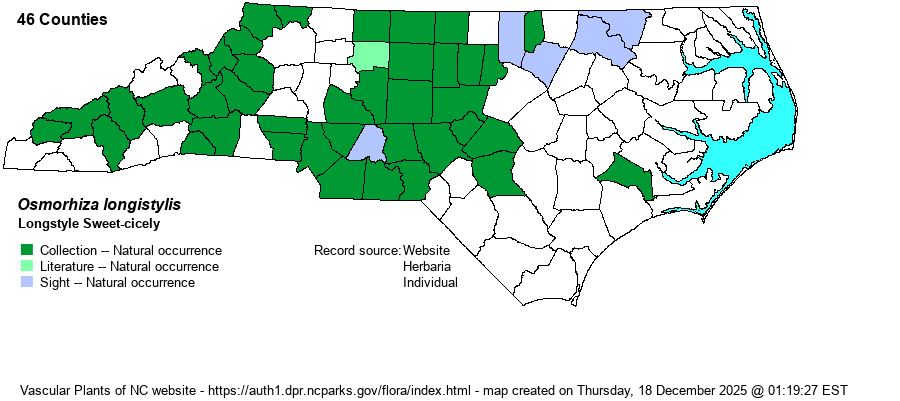| Author | (Torrey) de Candolle | |
| Distribution | Present over most of the Mountains, as well as most of the Piedmont, and sparingly into the upper Coastal Plain along rich brownwater river floodplains (Roanoke and Cape Fear); disjunct to Jones County in the eastern Coastal Plain.
This is a broad-ranging species, from much of Canada south to central GA, southern AR, and northeastern TX. | |
| Abundance | Fairly common to locally common in most of the Mountains, but seemingly scarce in the adjacent western Piedmont. However, fairly common to common in most of the central and eastern Piedmont. Locally fairly common along the upper Roanoke and Cape Fear rivers, but extremely rare into the eastern Coastal Plain. | |
| Habitat | As with O. claytonii, this species grows only in rich hardwood forests. It occurs in Rich Cove Forests, Basic Mesic Forests, and in rich (brownwater) bottomland hardwoods. Habitat distinctions between these two species in NC have not been described. | |
| Phenology | Blooms in April and May, and fruits in May and June. | |
| Identification | The two Osmorhiza species are very similar and easily confused by many people. They are moderately stout, growing to 2-3 feet tall, with branches in the upper portions. The alternate leaves are generally triangular in overall shape, but they are bipinnately or tripinnately divided into smaller segments. Each segment is ovate to triangular in shape, strongly cut and serrated, with each one being about 2 inches long and 1-inch wide at most. The umbels on the branch tips are compound like in most other genera, with numerous small white flowers. In this species, there are 4-6 umbellets per umbel, and 9-18 flowers per umbellet, on shorter rays (1-2 inches long), and thus the umbel looks rather crowded. In O. claytonii, there are usually only 3-5 umbellets per umbel, on rays that are 3-4 inches long, with just 4-7 flowers per umbellet, and thus the umbel appears relatively open and uncrowded. Other features are that the style in this species is longer than the petals, whereas in O. claytonii the style is shorter than the petals. For other characters, see Weakley (2020) and other keys, though this species has a rather smooth stem as opposed to a mostly hairy stem in O. claytonii. The genus should be identified by its growing in rich forests, with strongly triangular-looking leaves, cut more finely into additional triangular-looking segments -- quite fern-like in overall appearance. When you break some leaves, you should get a strong anise or licorice fragrance. | |
| Taxonomic Comments | None
| |
| Other Common Name(s) | Smooth Sweet-cicely, Anise-root, Longstyle Sweetroot. Neither of the two Osmorhiza species has a frequently-used common name. | |
| State Rank | S4? [S5] | |
| Global Rank | G5 | |
| State Status | | |
| US Status | | |
| USACE-agcp | FAC link |
| USACE-emp | FACU link |

